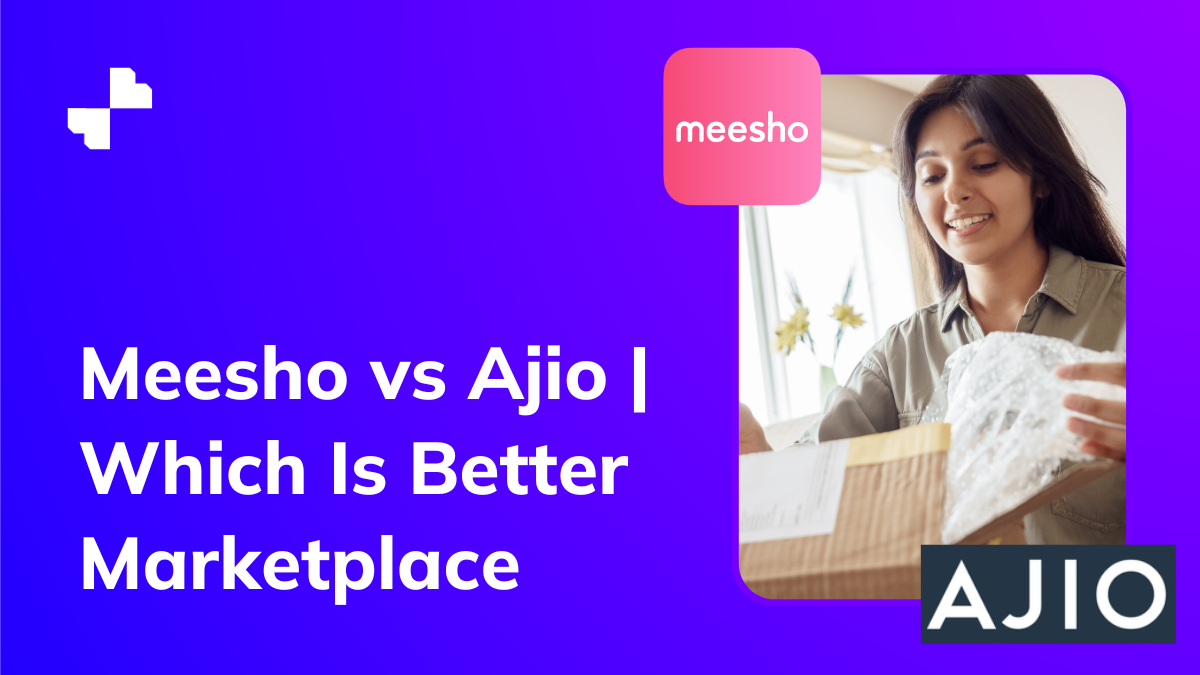India’s leading e-commerce platforms Meesho and Ajio allow business owners to grow their brands and make a name in the vast world of e-commerce. Although both marketplaces offer quality products at the cheapest price to the shoppers, they have their own business models and policies to conduct trade.
Here are some characteristic differences between to two famous e-commerce marketplaces,
1. Registration
The registration process of both platforms is pretty strict and needs legal documents to prove your brand’s identity and that you are an authentic seller. To register as a Meesho Seller, download the application and go to ‘Become a Supplier’ on the ‘Account’ tab. Read this article for a detailed guide to register as Meesho Supplier. As for selling on Ajio, you must register as a Reliance Retail supplier at this link. The documents required are as followed,
Meesho
- A GSTIN
- An active bank account
- Mobile number
- Email ID
Ajio
- PAN Card
- Aadhar Card
- MSME certificate
- Bank account details along with a canceled cheque.
- Logo (if have any)
- GST Details
- CIN and TIN certificate (If own a private company)
- Trademark certificate
As long as they have all the above-mentioned documents, they start selling on the respective platforms immediately.
2. Products To Sell
Meesho allows sellers to choose from a variety of categories and subcategories to sell their products. There are around 700+ categories in Meesho from clothing and accessories to electronic supplies so you can list any product on this platform. Visit the ‘Meesho Supplier Panel’ to list and manage your inventory.
Ajio is mainly a fashion marketplace therefore you can only become an Ajio seller if your brand focuses on clothing, shoes, and accessories. Download the catalog template from Ajio’s ‘Seller Central’ and fill in the information accurately to upload your listings.
3. Commission Fee
As we all know Meesho follows a ‘Zero Commission Fee’ policy, which means that selling or listing products on Meesho does not cost any money and it is absolutely free. Meesho charges zero fee and there are no hidden charges at any step. Therefore, you do not need any investment to become a Meesho Supplier.
On the other hand, Ajio charges an 8% to 10% commission rate on each sale. Registration and listing your products on Ajio do not cost money so you do not have to worry about paying before making a successful sale. But soon Ajio might change their business model and like Meesho launch the ‘Zero Commission’ program to help the sellers trade affordably.
4. Resources
Meesho provides sellers with features like the ‘Price Recommendation Tool’ which helps the merchants set the proper price for their products. While listing, this tool compares other shops and suggests the lowest possible price for the item to increase sales. Meesho also lets the sellers run customized ads and promotions for their shops with ‘Meesho Ads’ and Meesho Community. Even though Meesho charges for such ads, the sellers have full control over the time, price, and other information of the advertisements. Click to learn how to market your Meesho products.
Similarly, Ajio also provides inventory management tools for monitoring stock levels, replenishing products, and setting prices and availability. This platform also lets their seller run sponsored campaigns and ads that can be customized and managed completely by the seller on Ajio Commerce. For training and inquiries regarding e-commerce Ajio sellers can get access to ‘Seller University’ and ‘Seller Support’ upon registering.
5. Shipping
Meesho provides logistic partners for sellers to ship their items. Once an order is made, the sellers pack the item with shipping labels issued by Meesho. The logistic partner collects the parcel from the seller’s house or warehouse and directly delivers it to the customer’s address. The needs to pay for the shipping cost including returns.
With Ajio, a merchant can ship with two methods. The Dropship Fulfilment Model is similar to Meesho’s shipping system where the item is directly delivered from the seller to the buyers. But in the case of JIT Fulfilment Model, Ajio collects the item from the seller and quality checks it thoroughly in their warehouse. Once it passes the checks, the item is then packed and delivered to the customer.
6. Payment
Since Meesho does not take any charge for being a seller on their platform, the full payment is transferred to the seller’s bank account within 7 days of the product delivery including COD orders.
After charging the fee for each sale, Ajio pays the remaining profit directly to the seller’s bank account. The time of payment is scheduled by the seller while registering on the platform. It is always available to view the settlements on the dashboard.
Conclusion
It is always important to know about the website and its pros and cons before listing your products. Both platforms provide some similar and some different features that may pique your interest and what type of item you want to sell. See what suits you best and fulfills your needs first. There is no clear winner in the battle of selling on Meesho Vs Ajio, both have their own wins and losses so choose wisely.
